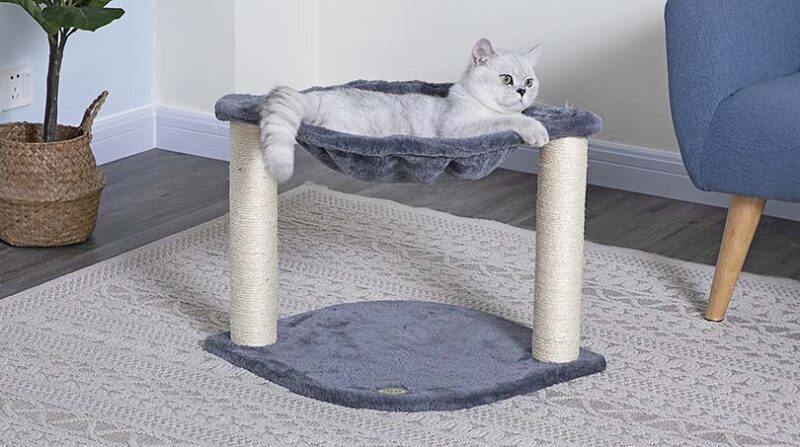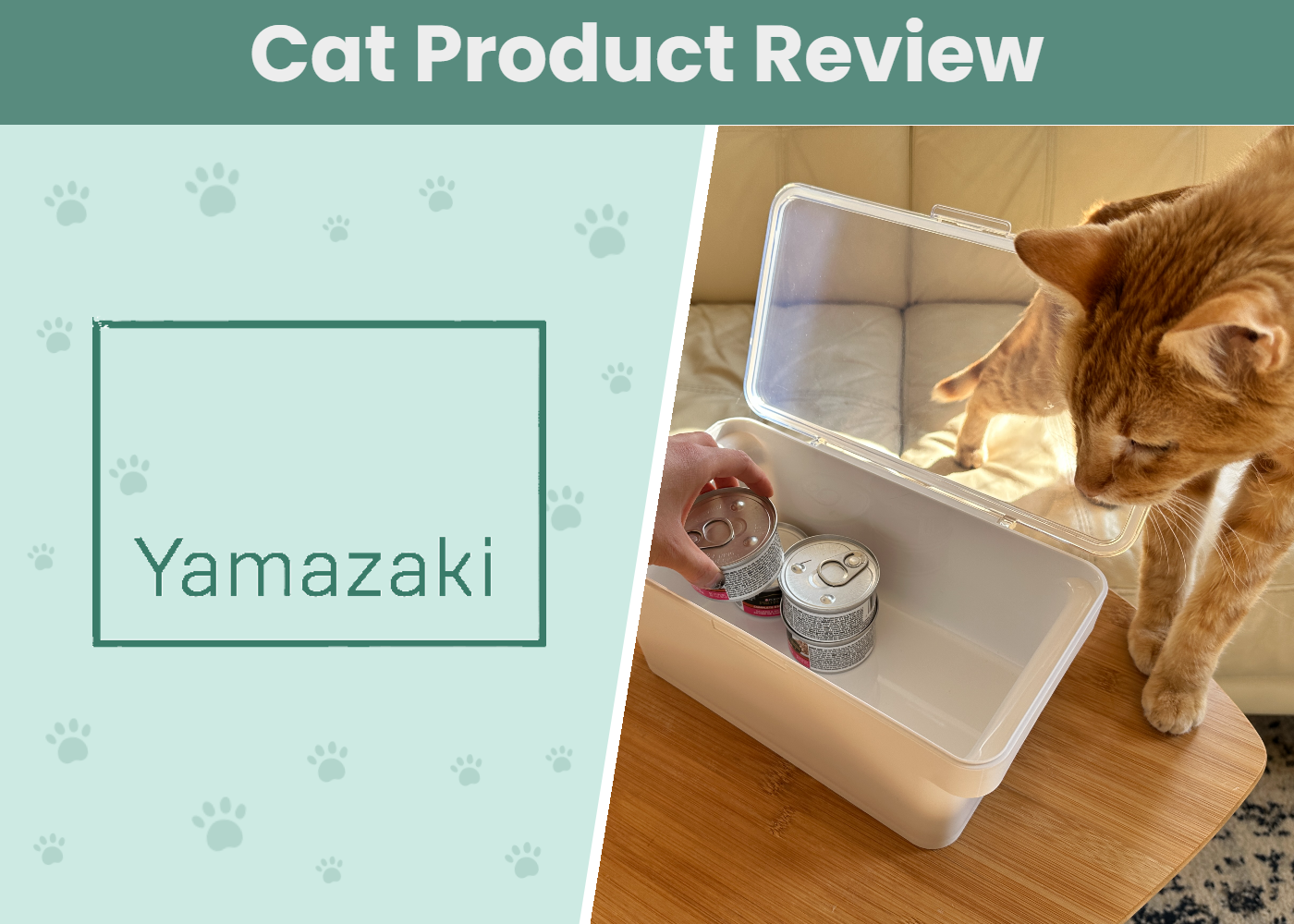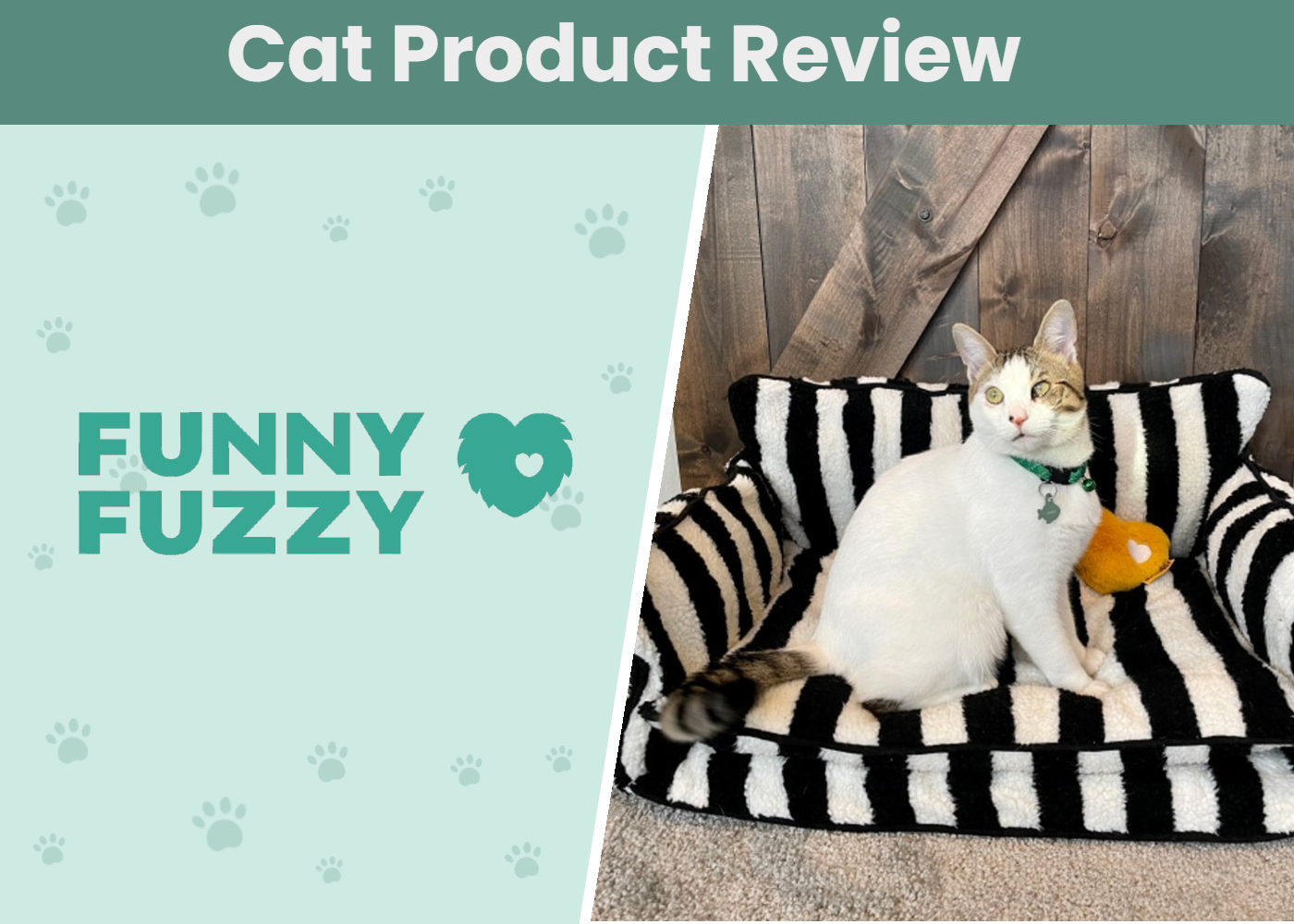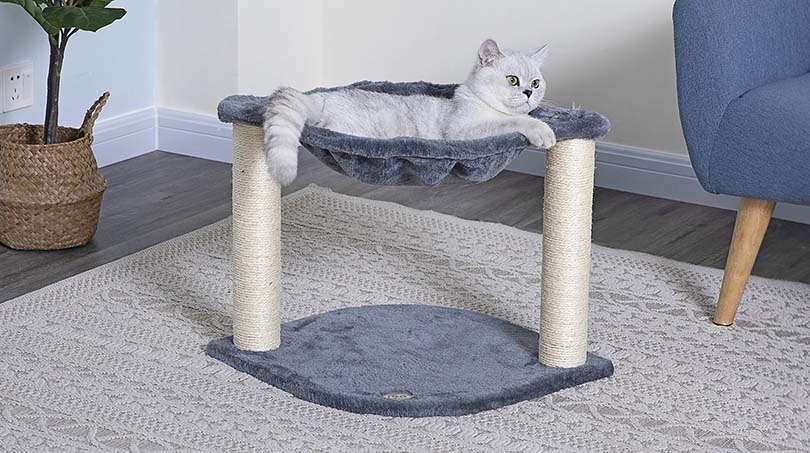
That’s why we took the time to track down 10 of the best budget cat trees out there. We create reviews of the 10 best options out there, including cat trees from 49″ tall all the way down to 18″ in size.
No matter what you’re looking for, we’re confident that your next cat tree is here and right within your budget.
A Quick Comparison of Our Favorites 2024
| Image | Product | Details | ||
|---|---|---|---|---|
| Best Overall |
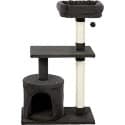
|
Frisco Cat Tree With Condo |
|
CHECK PRICE |
| Best Value |
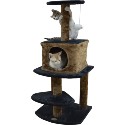
|
Go Pet Club Faux Fur Cat Tree |
|
CHECK PRICE |
| Premium Choice |
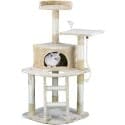
|
Go Pet Club Sisal Posts Cat Tree Condo |
|
CHECK PRICE |
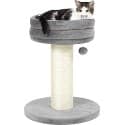
|
Frisco Heavy Duty Faux Fur Cat Tree |
|
CHECK PRICE | |
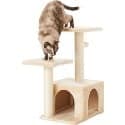
|
Frisco Faux Fur Cat Tree & Condo |
|
CHECK PRICE |
The 10 Best Budget Cat Trees
1.Frisco Cat Tree With Condo — Best Overall
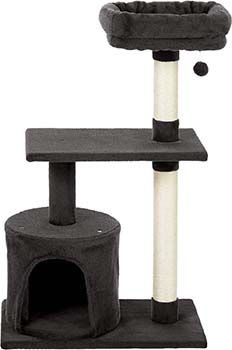
| Size: | 38″ |
| Colors: | Charcoal or gray |
| Materials: | Engineered wood, faux fleece, and sisal |
When you’re looking for the best overall budget cat tree, the Frisco Cat Tree with Condo is exactly what you’ve been looking for. It’s not the tallest cat tree out there, but at 38″, it’s not the smallest either. It’s a great medium-sized cat tree that comes in two different color options for you to choose from.
In addition to the tower and condo, it has a hanging toy and multiple scratch posts, both of which make it a cozy home for your cat. While it’s slightly more expensive compared to some other cat towers available, it’s undoubtedly a phenomenal deal for what you’re getting.
Of course, if you don’t have the cash up front, it doesn’t matter how great of a deal it is, you might still need to settle for something smaller.
- Taller design
- Multiple scratching posts
- Has a hanging toy
- Has a condo
- Slightly expensive
2. Go Pet Club Faux Fur Cat Tree — Best Value
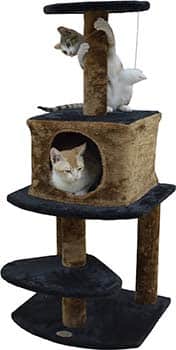
| Size: | 40″ |
| Colors: | Brown and black |
| Materials: | Engineered wood and faux fur |
The Go Pet Club Faux Fur Cat Tree is a little more expensive than some of the smaller cat trees out there, but for a 40″ cat tree, you’re not going to find a better deal.
It’s this price to size ratio that earns it our nod as the best budget cat tree for the money. It’s a tall cat tree that has multiple scratch posts, hanging toys, and a condo for your cat to hang out in. It’s everything that you could want in a cat tower at a great price.
- Great value
- Multiple scratch posts
- Hanging toys
- Has a condo
- Still more expensive than smaller cat trees
3. Go Pet Club Sisal Posts Cat Tree Condo — Premium Choice
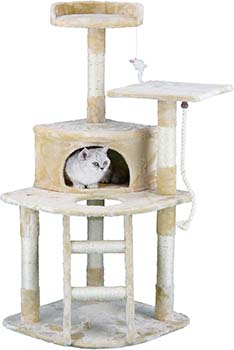
| Size: | 49″ |
| Colors: | Gray, beige, or brown |
| Materials: | Engineered wood, faux fleece, and sisal |
This Go Pet Club cat tree is a large cat tower at 49″, and it’s a phenomenal deal despite its high price tag.
There are three color options for you to choose from, and there are plenty of scratch posts for your cat to tear apart. There are also multiple hanging toys to keep your cat’s attention for a little while. With a cat tree this size, you can easily have multiple cats on it at once.
It’s an outstanding value for a large cat tree, so don’t let the premium nametag keep you from checking it out.
- Large cat tree option
- Three colors
- Plenty of scratch posts
- Multiple hanging toys
- Expensive
4. Frisco Heavy Duty Faux Fur Cat Tree — Best for Kittens
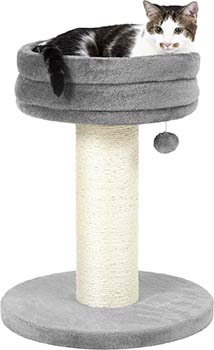
| Size: | 24.8″ |
| Colors: | Cream or gray |
| Materials: | Engineered wood, faux fleece, and sisal |
Frisco makes tons of outstanding cat products, and this Frisco Heavy Duty Faux Fur Cat Tree is just what a small kitten needs to relax after a long day of play. It’s low to the ground, which makes it easy for them to get into, and it has a hanging toy and a scratch post.
It also doubles as a cat bed, which means you’ll likely find your kitten taking a few naps here every day. But it’s not that tall and doesn’t have many spaces for your kitten to jump to. This might be fine for a kitten, but as they grow into a cat, they might outgrow this cat tree altogether.
Fortunately, it’s a more affordably priced option, so you aren’t spending a ton of money on a cat tree that they might outgrow before too long.
- Affordable
- Has a scratch post
- Has a hanging toy
- Doubles as a cat bed
- Not that tall
- Not many spaces to jump to
5. Frisco Faux Fur Cat Tree & Condo
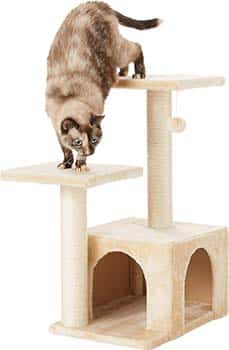
| Size: | 28″ |
| Colors: | Cream |
| Materials: | Engineered wood, faux fleece, and sisal |
A large Frisco cat tree that you should consider is the Frisco Faux Fur Cat Tree & Condo. It has a few platforms and a condo for cats to hang out in. It is a few inches taller than 2 feet, though that doesn’t make it big.
But it’s an extremely affordable option. If you have something to set it on, like an end table, then you can achieve the same height that some other cat towers have for a fraction of the price. Finally, this cat tower has two scratch posts, which gives your cat a place to trim their claws without wrecking your furniture.
- Affordable
- Two scratch posts
- Two platforms to jump to and from
- Has a condo
- Small cat tree
6. Catry Sisal Cat Tree
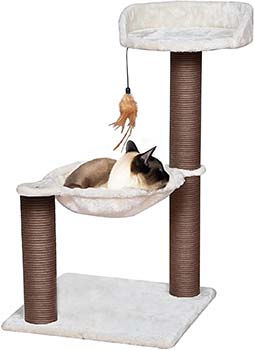
| Size: | 28″ |
| Colors: | Brown and cream |
| Materials: | Cardboard, faux fleece, and sisal |
Catry might not be the biggest name in the industry, but that doesn’t mean they don’t make an extremely affordable cat tree that you should check out. It has a faux fleece and sisal covering, but don’t let that fool you. Instead of the engineered wood that most cat trees use as the structure, Catry made this one from cardboard.
This material is far less durable than wood, but it’s the reason that it’s such a low-priced option. With a hanging feather toy, multiple scratch posts, and two platforms, it’s a great choice for your cat — as long as you don’t have kids or other individuals trying to climb all over the tree.
This cat tree doubles as a cat bed too, which means it’s an excellent place for your cat to kick back and sleep after roaming the house all day.
- Affordable
- Two platforms to jump to
- Has scratch posts
- Doubles as a cat bed
- Hanging teaser feather toy
- Cardboard frame isn’t that durable
- Not that tall
7. Frisco Faux Fur Cat Tree
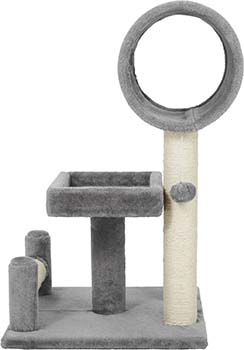
| Size: | 28″ |
| Colors: | Gray or animal print |
| Materials: | Engineered wood, faux fur, and sisal |
When you’re looking at cat trees, there are plenty of design options for you to choose from. The Frisco Faux Fur Cat Tree has a faux fur covering, multiple scratch posts, two platforms, and hanging toys.
This tree has a unique design compared to many other cat trees, so you need to think about what your cat will like best. Do note that this product is a bit expensive.
- Multiple scratch posts
- Two platform levels
- Multiple hanging toys
- Comfortable for your cat
- Not that tall
- Slightly expensive for what you get
8. Go Pet Club Faux Fur Cat Tree
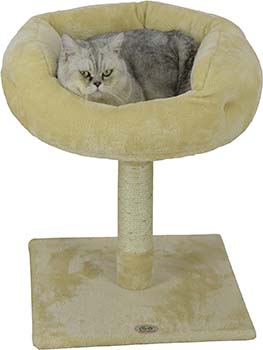
| Size: | 24″ |
| Colors: | Beige, brown, or gray |
| Materials: | Engineered wood, faux fur, and sisal |
This Go Pet Club Faux Fur Cat Tree is a super affordable cat tree, even if it is on the smaller end of things. It uses sisal scratch posts that your cat will love, and it doubles as a cat bed for the ultimate kitty comfort. That’s especially true when you take a look at the faux fur cat bed on top.
It’s the epitome of kitty comfort, and your cat will undoubtedly enjoy snuggling up at the top for naps and a full night’s sleep. Just keep in mind that besides the scratch posts and the cat bed on top, there’s not much to it. AT 24″ tall, it’s definitely on the shorter side of things.
- Affordable
- Sisal scratch posts
- Doubles as a cat bed
- Luxurious cat bed on top
- Small
- Not much to it
9. Frisco Faux Fur Cat Tree
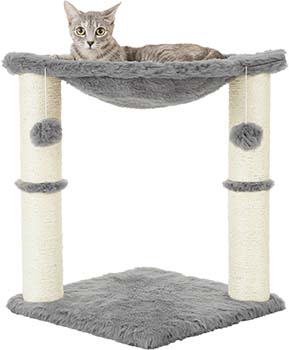
| Size: | 20″ |
| Colors: | Ivory, gray, black, or cheetah print |
| Materials: | Engineered wood, faux fur, and sisal |
This Frisco cat tree is super affordable, but since it only stands at 20″, your cat might not think that it’s the best thing out there.
Still, it has two hanging toys for your cat to play with, and it has two scratch posts. The top-level doubles as a cat bed, and that might be all your cat views this as. That’s not really a problem, though, and we’re sure your cat will appreciate having a comfortable place to sleep.
Just keep in mind that there’s not too much to this cat bed, and it doesn’t go that high.
- Affordable
- Two hanging toys
- Doubles a cat bed
- Two scratch posts
- Only one tower level
- Not much to it
- Does not go that high
10. Go Pet Club Faux Fur Cat Tree
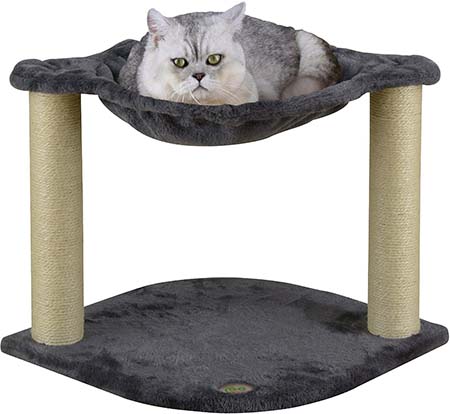
| Size: | 18″ |
| Colors: | Beige or gray |
| Materials: | Engineered wood, faux fur, and sisal |
This Go Pet Club cat tree is one of the smallest cat trees available, but when you look at the price, it doesn’t reflect that fact.
While it has an extremely durable construction that will last a long time, at this price, you can get a similar cat tree that has at least another 10″ in height. Still, it is durable and has two scratch posts that your cat will love.
But otherwise, it doesn’t have much to it. This cat tree works best as an elevated cat bed, but it comes down to your cat’s temperament if they’ll even use it.
- Extremely durable construction
- Two scratch posts
- Doubles as a cat bed
- Expensive for what you get
- One of the smallest cat trees on the market
- Does not have much to it
Buyer’s Guide: Choosing the Best Budget Cat Tree
If you’re still confused about which cat tree is best for you after reading these reviews, you’re not alone. That’s why we created this comprehensive buyer’s guide, to walk you through everything that you need to know when picking out a cat tree.
Checking Out the Size
For your cat, the most important thing for a cat tree is how high the top platform is. Cats love to climb, and if they feel like they’re still below everything after climbing onto the cat tree, they’ll likely find something else to climb.
If you’re going for a cat tree that’s shorter than 36″, we highly recommend finding somewhere higher to place it. A good choice would be an end table that you don’t mind your cat jumping on. Of course, you don’t have to do this, but there’s a decent chance that you’ll still find your cat climbing on things that you don’t want them to otherwise.
For tall cat trees, you can simply place them on the ground, and your cat should feel like they’re getting high enough to fulfill their climbing instincts.
Features to Look For
When it comes to cat trees, there are three key features that you need to look for (besides the maximum height). The first is hanging toys. Cats love to bat things around, and for something to really feel like their own space, they need a little entertainment. Hanging toys are a great way to provide this, but keep in mind that you’ll likely need to replace them from time to time.
The second feature is the scratch posts. Cats need to scratch to keep the length of their nails in check. If you don’t give them an acceptable outlet, they’re going to do it in places that you don’t want them to. A cat tree where they can scratch while climbing and lounging fills two needs for them, and that’s a sure winner in a cat’s eyes.
The last feature that you should consider is the condo. Essentially, a condo is a fancy name for a cat cave. It’s a place where they can go to feel completely enclosed. This should be their safe space, and when they’re there, you should leave them alone as much as possible. Just like you need a place to get away from things sometimes, so does your cat. A condo gives them that space.
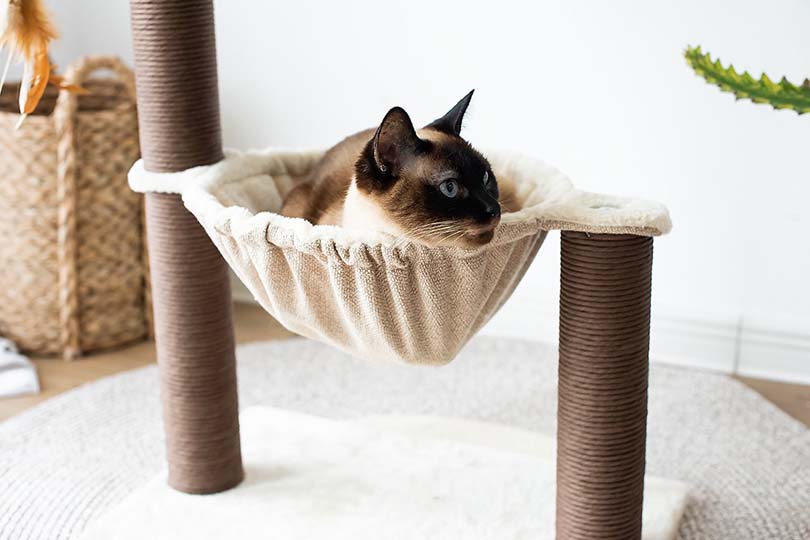
How Long Should a Cat Tree Last?
Most sites don’t like to give a clear-cut answer on how long a cat tree will last. First, it depends on how much and how your cat uses the tree. If your cat spends most of their time scratching it up, it’s clearly not going to last as long as one that doesn’t get used at all.
The second factor is the quality of the cat tree. A completely cardboard cat tree won’t last as long as one with a wood frame, and that’s completely normal. Once you factor these things in, you can expect a cat tree to last anywhere from 1 to 5 years.
Heavy scratchers with a low-quality cat tree will wear it out in a year, while a high-quality cat tree that receives moderate use can reasonably last about 5 years.
Can You Replace the Scratching Posts?
It depends on the cat tree. Some cat tree companies sell replacement scratch posts, while others want you to replace the entire cat tree. While that might seem a little excessive, when you look at the fact that most of the cat tree is the scratching posts, it’s not all that surprising.
Do your research before purchasing a new one, but be prepared for the fact that you’ll likely need to purchase a new cat tree.
Conclusion
If you’re still unsure about what cat tree you need after reading these reviews, don’t overthink it. The Frisco Cat Tree with Condo and the Go Pet Club Faux Fur Cat Tree are our top two choices for a reason. They’re both great values and your cat will love them.
Contents
- A Quick Comparison of Our Favorites 2024
- The 10 Best Budget Cat Trees
- 1.Frisco Cat Tree With Condo — Best Overall
- 2. Go Pet Club Faux Fur Cat Tree — Best Value
- 3. Go Pet Club Sisal Posts Cat Tree Condo — Premium Choice
- 4. Frisco Heavy Duty Faux Fur Cat Tree — Best for Kittens
- 5. Frisco Faux Fur Cat Tree & Condo
- 6. Catry Sisal Cat Tree
- 7. Frisco Faux Fur Cat Tree
- 8. Go Pet Club Faux Fur Cat Tree
- 9. Frisco Faux Fur Cat Tree
- 10. Go Pet Club Faux Fur Cat Tree
- Buyer’s Guide: Choosing the Best Budget Cat Tree
- Checking Out the Size
- Features to Look For
- How Long Should a Cat Tree Last?
- Can You Replace the Scratching Posts?
- Conclusion


